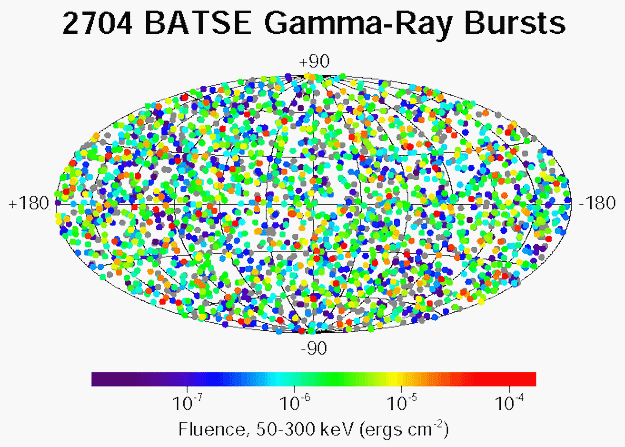Observations Indicating Geocentrismby Mark WyattApril 10, 2008There are a number of observations and experimental results which indicate that: 1. We are in a central location; 2. We are not moving; After reading the section on Big Bang Assumptions, you should realize that our observations are shaped by our assumptions and our philosophy. The philosophical view that typifies the type of philosophy that shapes current cosmology and cosmogony is nicely summarized by Paul Davies, editor of Nature journal in his comments on George Ellis' observationally accurate model with earth in a prefererd (central) position: Often the simplest of observations will have the most profound consequences. It has long been a cornerstone of modern science, to say nothing of man’s cosmic outlook, that the Earth attends a modest star that shines in an undistinguished part of a run-of-the-mill galaxy. Life arose spontaneously and man evolved on this miscellaneous clump of matter and now directs his own destiny without outside help. This cosmic model is supported by the Big-Bang and Expanding Universe concepts,...George Ellis in this article is more complex than this, but his basic thrust is to put man back into a favored position in the cosmos. His new theory seems quite consistent with our astronomical observations, even though it clashes with the thought that we are godless and making it on our own. This philosophy has a direct impact on what cosmologists will and will not consider, and directly impacts how they create their models. As George Ellis said in his article (quoted in Assumptions): ...we are using philosophical criteria in choosing our models. A lot of cosmology tries to hide that. And as Hubble said regarding his apparent observations of centrality (again, see Assumptions): ...we disregard this possibility... There are many more examples, but this will suffice to make the point. So, if we really want to get back to basics we should start with observations and basic experiments. Astronomers are constantly mapping and categorizing the skies. One phenomenon, which does imply centrality are isotropic distributions i.e., observations that some phenomenon surrounds us equally from all directions. RedshiftOn previous pages we have already commented on redshift. Hubble was one of the
discoverers of redshift. He detected redshift isotropically distributed all around us. He Said (The Observational Approach to Cosmology): …Such a condition would imply that we occupy a unique position in the universe, analogous, in a sense, to the ancient conception of a central Earth...This hypothesis cannot be disproved, but it is unwelcome and would only be accepted as a last resort in order to save the phenomena. Therefore we disregard this possibility.... the unwelcome position of a favored location must be avoided at all costs.... such a favored position is intolerable...Therefore, in order to restore homogeneity, and to escape the horror of a unique position…must be compensated by spatial curvature. There seems to be no other escape." Science has disregarded the possibility of redshifts indicating that (as we observe) we actually are in the center. As Hubble indicated, instead, science has adopted general relativity to "escape" the possibilty. Amusingly, general relativity is one of the cosmological frameworks that allows geocentrism! Stephen Hawking has stated that we disregard the possibility out of "modesty" (See Assumptions). As we know, another interpretation of redshift is a gravitational phenomenon. As Paul Davies said in Nature, while discussing this very issue, ...If the Earth were at the center of the universe, the attraction of the surrounding mass of stars would also produce redshifts wherever we looked!... Gamma Ray BurstsGamma ray bursts are distributed isotropically throughout our view. They show-up, roughly one per day randomly in the sky. The following figure shows 2704 GRBs detected by the BATSE satellite.
According to Jonathan I. Katz, in The Biggest Bangs: The Mystery of Gamma-Ray Bursts, the Most Violent Explosions in the Universe (2002), GRBs are a Copernican Dilemna: The uniform distribution of burst arrival directions tells us that the distribution of gamma-ray-burst sources in space is a sphere or spherical shell, with us at the center (some other extremely contrived and implausible distributions are also possible). But Copernicus taught us that we are not in a special preferred position in the universe; Earth is not at the center of the solar system, the Sun is not at the center of the galaxy, and so forth. There is no reason to believe we are at the center of the distribution of gamma-ray bursts. If our instruments are sensitive enough to detect bursts at the edge of the spatial distribution, then they should not be isotropic on the sky, contrary to observation; if our instruments are less sensitive, then the N ∝ S-3/2 law should hold, also contrary to observation. That is the Copernican dilemma. This dilemna has led science to propose that the GRBs occur billions of light years away, and are caused by stars collapsing into black holes producing astronomical amounts of energy. All because they cannot tolerate the alternative (we are in a central position). More detailed discussion is availble on the gamma ray burst page of this site. |

